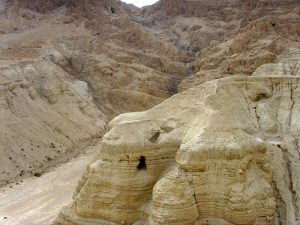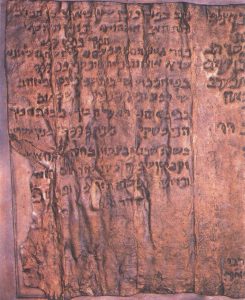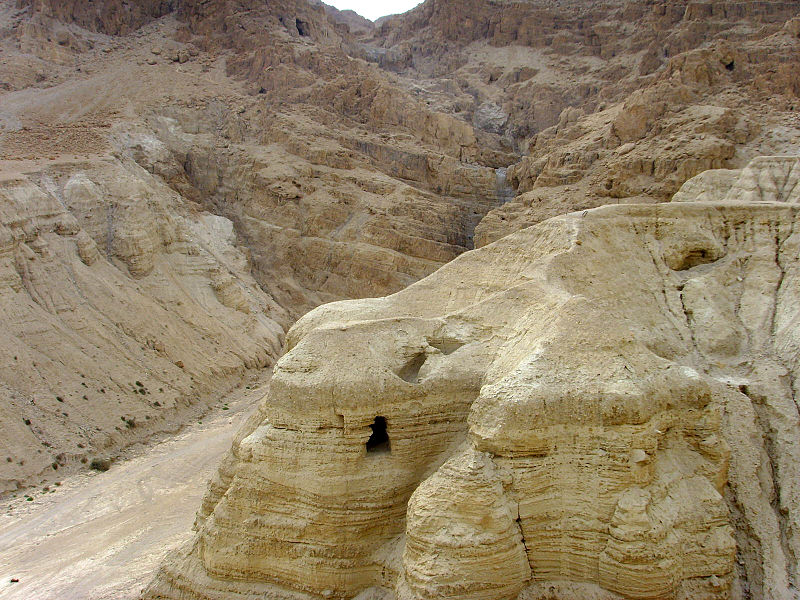
Between the years 1947 and 1954, in 11 caves on the northwest shore of the Dead Sea, a group of 930 ancient texts, dating back to 250 BC to 50 AD, were discovered. They amazed the world. Biblical texts, along with other sectarian and nonsectarian Jewish works were brought to light. They included Biblical books and other works a thousand years older than any other copies known to the world. They are known as the Dead Sea Scrolls.
The initial find of seven scrolls was made by a Bedouin shepherd in the spring of 1947. These scrolls were found in earthenware jars inside a mountainside cave near the Dead Sea. The story goes he was looking for one of his goats which strayed off path. What he discovered was not only his goat, but a cave holding 7 scrolls; two of which are the oldest copies we have today of the Biblical book of Isaiah.
Once knowledge of this find spread, the area was excitedly searched for other caves holding scrolls and ancient artifacts. Over a period of around seven years, around 230 biblical manuscripts and 700 documents concerning Jewish life were discovered. Although many were fragmentary, they were still one of the most historical finds of the time.
One of the most mysterious texts retrieved from within the caves is known as the Copper Scroll. It was found in cave 3 in 1952, and as its name implies, the scroll was made up of sheets of copper. The scroll was found in two pieces and badly corroded. It remained unable to be unrolled and read until it was sent to the laboratory of Professor H. Wright Baker of Manchester University College of Technology in England in 1956. Here it was carefully cut into sections, so the text of the copper scroll could be read for the first time since it was hidden away.

What was written was even more mysterious than the scroll’s utilization of copper; the only scroll of the 930 to have been on copper. The text of the scroll listed 64 places to find hidden treasure. Not just a small amount of treasure, but of huge significance. In modern terms, the secreted treasures of the Copper Scroll total approximately to 26 tons of gold and 65 tons of silver. A tremendous amount.
One of the first two questions to ask is, ‘Is the treasure real?’ and ‘Are the treasures still hidden?’
Most scholars tend to lean towards the idea that the treasure is real for the effort of incising the text on copper is extremely tedious. The incentive for a person to do such, for purely ‘fun’ or ‘fictional purpose’ during this time is difficult to imagine. For this reason, alone, it is believed to be real.
The next question remains unanswered. The text of the Copper Scroll listing the locations of the hidden treasures are coded and can’t be easily determined. Many have tried to follow the instructions of the Copper Scroll to find the treasure, or at least confirm the locations existed, but to no success.
Examples of secreted locations are as follows:
“Sixty five bars of gold lie on the third terrace in the cave of the old Washers House”
“Forty two talents lie under the stairs in the salt pit”
“Enter into the hole of the waterproofed reservoir of Manos, descend to the left, forty talents of silver lie three cubits form the bottom”
The last location on the list states that another ‘scroll’, like the Copper Scroll exists.
“A copy of this inventory list, its explanation and the measurements and details of every hidden item are in the dry underground cavity that is in the smooth rock north of Kohlit. Its opening is towards the north with the tombs at its mouth”
This is not known to have ever been found. Is it made of copper as well? No one knows.
Although many have tried, searchers have been unable to clearly identify any of the locations.
It is believed the Dead Sea Scrolls were placed in the caves shortly before the Romans invaded the region around the year 70 AD, and those who hid the scrolls were planning to return, but never did.
Some believe the Copper Scroll lists treasures from the Jerusalem Temple which were to be used later to rebuild the Temple. It has been suggested, Temple officials hid the treasures before destruction and invasion, created the list (evidently two of them), and secreted them away. One hidden in cave 3 and the other ‘in the smooth rock north of Kohlit’.
While the area surrounding the caves, and further beyond, have been searched, none of the treasure as described in the Copper Scroll have been found or have ever been recorded to have been found.
It should be said the task is complex. There is a possibility the treasures were scattered and hidden miles away from where Dead Sea Scrolls were discovered. In one of the descriptions, the location Mount Gerizin is provided. Although not exactly the same, there is a Mount Gerizim which was known and is about 40 miles north of Jerusalem. Quite a distance.
The ambiguous nature of the text, possible vast area it was hidden, and passage of time, leaves discovery difficult.
The Copper Scroll, and the treasures it lists, could remain a mystery for quite a long time more. However, the challenge to solve the mysteries of the Scroll doesn’t stop many from doing research, in hopes of coming across a small detail that could cast open all that was hidden. Time will tell.
Best of luck with all that you seek! Treasure the Adventure!


YOUR TIMING IS IMPECCABLE
http://www.dmns.org/dead-sea-scrolls/
UNFORTUNATELY LOOKS LIKE OUR COPPER FRIEND CAN’T MAKE THE TRIP
https://www.dmns.org/media/3139976/dead-sea-scrollsdescriptionsrotation-1.pdf
Nice catch DUMBFOUNDED.
Exactly, impeccable indeed just in time. Another treasure hunt. Looks like the Denver museum will be a good place to start.
I have always marveled how the finding of the DEAD SEA SCROLLS (1947) corresponds to the nation Israel becoming a nation again in 1948. Both Israel and the scrolls were basically lost of hidden for 2000 years—-then they both come back into view a year apart—1947/1948. To me that is far more than coincidence.
This is fascinating stuff.
I presume that those seeking the copper scroll’s treasure are also researching the other scrolls for clues?
If i remember correctly the copper scroll is in Jordan in the Museum .I think that the copper scroll is from a much earlier time maybe Jeremiah ‘s time .
That would make sense, Wig.
Jeremiah did take the Ark of the Covenant…somewhere…to hide it.
It makes sense that other treasure would have been hidden at that time as well.
word on the street is that the cave with the incense and such from 68ish AD was excavated and folks at Gildead Farm are presently remaking the incense now for the 3rd temple. no word on the red heifer ash or ark, those are tbd I suppose.
supposedly I held some of that ancient balm in my hand tonight. looked a lot like leftover achiote fwiw.
https://m.youtube.com/watch?v=1vJBf6Um2XU